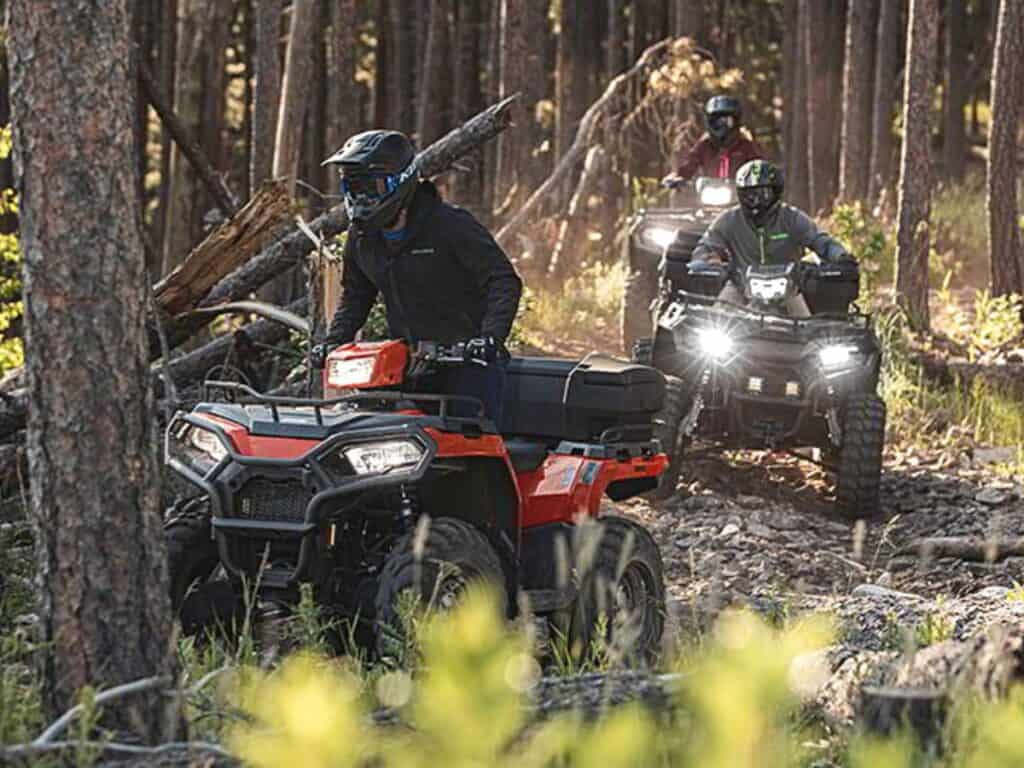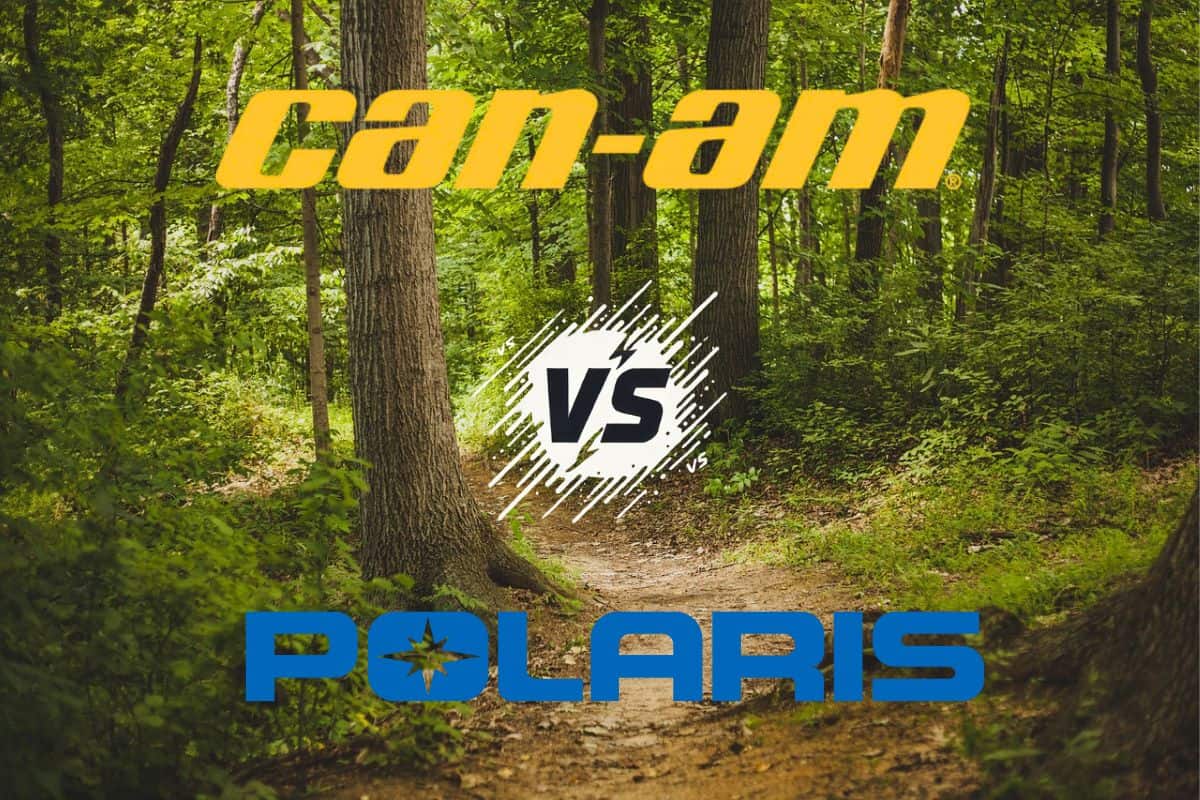Is Can-Am Better Than Polaris?
This question has been debated for years, sparking intense debates in off-road communities and showrooms.
As two titans in the world of ATVs and UTVs, Can-Am and Polaris have been locked in fierce competition, constantly pushing each other in performance, innovation, and design.
But is one better than the other?
In this guide, we’ll cover the strengths and weaknesses of these two ATV and UTV brands to help you determine if Can-Am is indeed better than Polaris. By taking a look at their histories, product ranges, performance metrics, reliability, and customer satisfaction.
By the end, you’ll have a clear picture of how Can-Am and Polaris compare, to hopefully help you decide which brand is the better choice for your specific needs.
Key Takeaways
- Both Can-Am and Polaris are leading manufacturers of high-quality ATVs and UTVs, with Can-Am often excelling in high-performance models while Polaris offers a broader product range.
- The choice between Can-Am and Polaris largely depends on individual needs, with factors like intended use, performance requirements, local dealer support, and personal preferences playing a large role in the decision.
- Neither brand can be declared “better” overall, as both have strengths in different areas and offer competitive options across various segments of the powersports market.
Brand Histories & Reputations
When exploring the question “Is Can-Am better than Polaris?”, it’s important to understand the rich histories and established reputations of these powersports giants, as it will help to gain a better understanding of each brand.
Polaris: A Legacy in Off-Road Vehicles
Polaris has a rich history dating back to 1954, when it was founded in Roseau, Minnesota.
The company began by manufacturing snowmobiles, with their first model rolling off the assembly line in 1956.
Polaris quickly established itself as a pioneer in the powersports industry, expanding into all-terrain vehicles (ATVs) in the 1980s with the introduction of the Scrambler ATC and Trail Boss in 1985.
Over the decades, Polaris has grown into a global powersports leader, developing a reputation for innovation and quality across multiple product lines. The company has consistently pushed boundaries, introducing popular models like the Polaris RANGER side-by-side in 1997 and the RANGER RZR in 2007, which was touted as the first trail-capable side-by-side with the fastest acceleration in its class.
Polaris has also expanded through acquisitions, including the purchase of Indian Motorcycle in 2011 and Boat Holdings in 2018.
The company’s commitment to innovation is also evident in its recent ventures into electric vehicles, partnering with Zero Motorcycles to launch electric versions of their popular models.
With a presence in over 120 countries, Polaris has cemented its reputation as an industry leader in powersports, known for its diverse product range and commitment to outdoor recreation.
Can-Am’s Journey in Powersports
Can-Am, a subsidiary of Bombardier Recreational Products (BRP), has a shorter but equally impactful history in the powersports industry. The brand was created in 1972 as a motorcycle manufacturer, quickly making a name for itself in off-road racing.
Despite initial success, however, economic challenges led to a pause in Can-Am’s operations in the 1980s. However, the brand was revitalized in 2006 when Bombardier reintroduced Can-Am with a focus on all-terrain vehicles (ATVs). This rebirth marked the beginning of Can-Am’s modern era as a major player in the off-road market.
Can-Am has since built a strong reputation for high-performance off-road vehicles, including ATVs and side-by-sides. The brand is known for its powerful Rotax engines and innovative designs that cater to both recreational riders and racers.
Can-Am has also expanded into on-road vehicles with the introduction of the Can-Am Spyder three-wheeled roadster in 2007.
In recent years, Can-Am has focused on pushing the boundaries of performance and technology in the powersports industry. The brand has gained a loyal following among off-road enthusiasts and has become a formidable competitor to established brands like Polaris in the ATV and UTV markets.
Brand Perception Among Off-Road Riders
Both Polaris and Can-Am have strong brand loyalty among riders.
- Polaris is often seen as a versatile, all-American brand with a long history of reliability and innovation across multiple vehicle types.
- Can-Am, on the other hand, has built a reputation for high-performance machines that appeal to thrill-seekers and competitive riders.
The question “Is Can-Am better than Polaris?” is often debatable, with supporters of each brand citing factors such as performance, durability, and innovation.
Ultimately, both brands have carved out their own niches in the market, with Polaris offering a broader range of products and Can-Am focusing on high-performance off-road vehicles.
Product Lineup Comparison: Can-Am vs Polaris
Both manufacturers offer a wide range of off-road vehicles catering to various needs, from recreational riding to utility work.
ATV Models: Can-Am vs. Polaris
Can-Am’s ATV lineup includes popular models like the Outlander and Renegade series. The Outlander is available in various configurations for play and work, while the Renegade series caters to sports enthusiasts, offering multiple high-performance trims.
Polaris counters with its Sportsman ATV line, which has built a reputation for versatility and reliability. The Sportsman series offers models ranging from entry-level to high-performance options, suitable for both work and recreation.
Both brands also offer youth ATVs, with Can-Am’s DS series and Renegade EFI competing against Polaris’ youth-oriented Sportsman models.
UTV & Side-by-Side Offerings
In the UTV market, Can-Am offers a robust lineup including the Defender, Maverick, and Commander series. The Defender is positioned as a work-oriented vehicle, while the Maverick X3 and new Maverick R target high-performance enthusiasts. The Commander series bridges the gap between utility and recreation.
Polaris offers an equally impressive UTV lineup, with the RANGER, RZR, and GENERAL lines. The RANGER series is Polaris’ utility workhorse, competing directly with Can-Am’s Defender. The RZR line, particularly models like the RZR Pro R, goes head-to-head with Can-Am’s Maverick series in the high-performance segment. Polaris’ GENERAL, like the Can-Am Commander, offers a blend of work and play capabilities.
A unique offering from Polaris is the XPEDITION, an adventure-focused side-by-side designed for extended backcountry exploration, which doesn’t have a direct counterpart in Can-Am’s lineup.
Specialty Vehicles & Niche Vehicles
Both brands have ventured into specialty markets. Can-Am has made a significant impact with its three-wheel on-road vehicles, the Ryker and Spyder series, which don’t have direct competitors from Polaris.
Polaris, on the other hand, has a broader range of specialty products. This includes snowmobiles and the Timbersled snow bike conversion kit, catering to winter sports enthusiasts. Polaris also owns Indian Motorcycle and produces the unique three-wheeled Slingshot roadster, expanding its presence in the on-road market.
In the commercial sector, both companies offer vehicles designed for work applications, with Polaris having a dedicated Commercial & Government division.
While Can-Am has announced upcoming electric motorcycles (Origin and Pulse), Polaris has already entered the electric vehicle market with products like the RANGER XP KINETIC.
Overall, Can-Am tends to focus more on off-road vehicles, while Polaris has a broader product range that extends into snowmobiles and motorcycles.
Head-to-Head Comparison Between Can-Am & Polaris

In this head-to-head comparison between Can-Am and Polaris, we’ll compare everything from performance and reliability to design and innovation.
Performance & Power
Both manufacturers offer powerful ATVs and UTVs, however, they approach performance and power in different ways.
- Engine Specifications and Technology: Can-Am utilizes Rotax engines across its lineup, which are known for their reliability and power output. These engines often feature advanced technologies like intelligent Throttle Control (iTC) and triple-cylinder configurations in high-performance models. Polaris, on the other hand, develops its own engines in-house, using technologies like ProStar and RZR XP Turbo R powerplants, offering a range of twin-cylinder and turbocharged options.
- Horsepower and Torque: In the high-performance UTV segment, Can-Am’s Maverick X3 X rs Turbo RR boasts up to 200 horsepower, while Polaris’ RZR Pro R offers up to 225 horsepower. In the utility segment, Can-Am’s Defender and Polaris’ RANGER models typically range from 50 to 100 horsepower, with variations based on specific models and intended use.
- Acceleration and Top Speed: Both brands offer impressive acceleration and top speeds in their performance models. Can-Am’s Maverick X3 claims 0-60 mph times under 4.5 seconds, while Polaris’ RZR Pro R boasts similar capabilities. Top speeds for both brands’ high-performance UTVs can exceed 80 mph in certain models, though they are often electronically limited for safety reasons.
Reliability & Durability
Is Can-Am More Reliable Than Polaris?
Both brands have invested heavily in improving reliability over the years. Can-Am has built a reputation for durable Rotax engines, while Polaris has focused on enhancing the overall robustness of their vehicles.
- Common Issues and Maintenance Requirements: Common issues for both brands include belt wear in CVT transmissions, suspension component wear, and electrical system problems in more feature-rich models. Maintenance requirements are similar, with regular oil changes, air filter cleanings, and belt inspections being crucial for both Can-Am and Polaris.
- Long-Term Durability: User experiences vary widely, with loyalists on both sides claiming superior durability for their preferred brand. Independent reports suggest that both Can-Am and Polaris produce durable vehicles when properly maintained, with differences often coming down to specific models rather than overall brand reliability.
Design & Ergonomics
Both manufacturers have invested heavily in creating vehicles that not only perform well but look good doing it.
- Aesthetics and Style: Can-Am offers a more aggressive, sport-oriented design across its lineup, even in utility models. Polaris tends to have a more rugged, utilitarian appearance, especially in its RANGER series. Both brands offer sleek, modern designs in their high-performance models.
- Comfort and Rider Experience: Both manufacturers prioritize rider comfort, especially in newer models. Can-Am often receives praise for its ergonomic seating and intuitive control layouts. Polaris has made significant strides in this area, with models like the RANGER XP featuring car-like comfort and amenities.
- Customization Options and Accessories: Can-Am and Polaris both offer extensive catalogs of OEM accessories and customization options. Polaris may have a slight edge in the extent of its offerings, particularly with its RANGER and RZR lines.
Technology & Innovation
In the competitive world of powersports, technology and innovation are key differentiators that can make or break a brand’s reputation.
- Can-Am Tech: Can-Am has introduced features like Smart-Lok front differential technology, intelligent Throttle Control (iTC), and advanced suspension systems like Smart-Shox in its high-end models.
- Polaris Tech: Polaris off-road vehicles feature RIDE COMMAND technology, Pro XP Live Valve suspension, and the DYNAMIX DV active suspension system in its premium offerings.
- Comparison of Smart Technologies and Connectivity: Both brands offer advanced connectivity features in their premium models. Can-Am’s Smart-Lok technology and Polaris’ RIDE COMMAND system are standout features, offering enhanced control and information to riders. The level of smartphone integration and GPS capabilities is comparable between the two brands’ top-tier models.
Off-Road Capabilities
Both manufacturers have built their reputations on producing off-road vehicles that can tackle challenging terrains with ease.
- Off-Road Capability: Both brands excel in off-road performance. Can-Am’s Maverick X3 is known for its desert-running capabilities, while Polaris’ RZR Pro R is equally at home in challenging terrain. In the utility segment, both the Can-Am Defender and Polaris RANGER offer excellent all-terrain capabilities.
- Suspension Systems and Ground Clearance: Can-Am utilizes technologies like Smart-Shox and FOX suspension components, while Polaris offers systems like DYNAMIX DV. Ground clearance is comparable between similar models from both brands, typically ranging from 10 to 15 inches in off-road-focused vehicles.
- Towing Capacity and Payload Comparisons: In the utility segment, both brands offer impressive capabilities. The Polaris RANGER XP 1000 boasts a towing capacity of up to 2,500 lbs, while the Can-Am Defender can tow up to 2,500 lbs in certain models. Payload capacities are similarly matched, with both brands offering options that can carry over 1,000 lbs in their cargo beds.
Price Points & Value for Money
When comparing Can-Am and Polaris to determine which brand offers better value, price points and overall value for money are key factors to consider.
- Cost Analysis: Pricing is competitive between the two brands, with variations depending on model and features. Entry-level ATVs from both brands start around $6,000-$7,000, while high-end performance UTVs can exceed $30,000.
- Resale Value Comparison: Both Can-Am and Polaris vehicles tend to hold their value well. Factors like model popularity, maintenance history, and local market demand influence resale values more than brand alone.
- Warranty and After-Sales Service: Can-Am offers a standard 6-month warranty on most models, with extended options available. Polaris typically provides a 6-month warranty on ATVs and a 1-year warranty on side-by-sides, also with extended options. After-sales service quality can vary by dealer for both brands.
Customer Support & Dealer Network
The strength of a brand’s customer support and dealer network can significantly influence the ownership experience and often plays a crucial role in brand reputation.
- Availability of Parts and Accessories: Both brands have extensive dealer networks and online parts availability. Polaris may have a slight advantage in the U.S. due to its longer history and larger dealer network.
- Dealer Experience and Support: Dealer experiences can vary greatly by location for both brands. However, both Can-Am and Polaris invest in dealer training and support programs to enhance customer experiences.
- Community and Brand Loyalty: Both brands have cultivated strong, loyal communities. Can-Am enthusiasts often praise the brand’s performance edge, while Polaris loyalists appreciate the brand’s American heritage and broad product range.
Making the Choice: Is Can-Am Better Than Polaris?

Ultimately, determining whether Can-Am is better than Polaris is largely subjective and depends on individual riders’ needs and preferences, as both brands offer high-quality, capable off-road vehicles across various segments.
Factors to Consider When Choosing Between Brands
When deciding between Can-Am and Polaris, consider the following key factors:
- Intended use: Are you primarily looking for a recreational vehicle, a utility workhorse, or a blend of both?
- Performance requirements: Do you need raw power, handling, or a balance of both?
- Terrain and climate: What type of environment will you primarily be riding in?
- Budget: Consider both initial purchase price and long-term ownership costs.
- Local dealer support: Evaluate the quality and proximity of dealerships for each brand in your area.
- Personal preferences: Consider design aesthetics, ergonomics, and brand reputation.
Matching Your Needs to the Right Brand
Can-Am might be the better choice for you if you:
- Prioritize high-performance and cutting-edge technology
- Prefer a more aggressive, sport-oriented design
Polaris could be the better option for you if you:
- Need a versatile vehicle that excels in both work and play
- Value a broader product range, including snowmobiles and motorcycles
- Prefer a more rugged, utilitarian design
The Verdict: Can-Am vs. Polaris in Different Categories
While it’s challenging to declare an overall winner, we can summarize how each brand performs in key categories:
- Performance: Both brands offer high-performance models, with Can-Am often having a slight edge in pure horsepower in comparable models.
- Reliability: Both manufacturers offer good reliability, with differences often coming down to specific models rather than overall brand reputation.
- Innovation: Can-Am and Polaris are both at the forefront of technological advancements in the industry.
- Value for Money: This varies by model, but both brands offer competitive pricing and features across their lineups.
- Off-Road Capabilities: Both excel in this area, with strengths in different types of terrain and riding styles.
- Customer Support: The quality of support can vary by location, but both brands have extensive dealer networks and support systems in place.
In conclusion, the question “Is Can-Am better than Polaris?” doesn’t have a one-size-fits-all answer.
Both brands offer high-quality, capable off-road vehicles that cater to different segments of the powersports market. The best choice depends on your specific needs, riding style, and preferences.
Because of this, we recommend test-riding models from both manufacturers, considering your long-term needs, and evaluating your local dealer support and network before making a final decision.
Whichever brand you choose though, you can rest assured that both Can-Am and Polaris offer best-in-class options for all your off-road adventures.
Other Powersport Brand Resources:
- CFMoto UTV: What You Need to Know
- Gator UTV: 10 Things You Need to Know (Common Questions)
- How Much is a Kawasaki ATV (Full Cost Breakdown)
Recent Posts
Whether you're an adult looking for a new adventure or introducing your kids to the sport, finding the best beginner dirt bike is crucial to kick-start your off-road journey on the right...
Electric side-by-sides are revolutionizing the powersports industry with their impressive performance, eco-friendliness, and cutting-edge technology. Because of this, more and more powersport...

